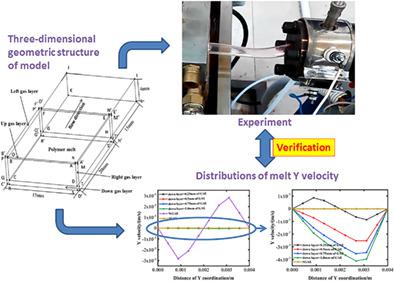当前位置:
X-MOL 学术
›
Polym. Eng. Sci.
›
论文详情
Our official English website, www.x-mol.net, welcomes your
feedback! (Note: you will need to create a separate account there.)
Numerical and experimental studies on the effect of thickness difference between up and down gas layers on sheet polymer gas‐assisted extrusion forming
Polymer Engineering and Science ( IF 3.2 ) Pub Date : 2020-08-12 , DOI: 10.1002/pen.25485 Shi‐Yu Jiang 1 , He‐Sheng Liu 1, 2 , Xing‐Yuan Huang 1 , Zhong Yu 1, 3 , Rui‐Zhe Wang 1
Polymer Engineering and Science ( IF 3.2 ) Pub Date : 2020-08-12 , DOI: 10.1002/pen.25485 Shi‐Yu Jiang 1 , He‐Sheng Liu 1, 2 , Xing‐Yuan Huang 1 , Zhong Yu 1, 3 , Rui‐Zhe Wang 1
Affiliation

|
In this study, to make gas‐assisted extrusion (GAE) can be better applied to conventional horizontal extrusion forming process, the thickness difference between up and down gas layer was simulated for the first time by GAE of molten high‐density polyethylene sheet. In order to ascertain the effects of the thickness difference of up and down gas layers on sheet extrusion molding, a method based on the model of two‐phase (gas and melt) flow was put forward, and an outer‐layer GAE isothermal numerical simulation made by POLYFLOW was explored and researched. The numerical results analysis indicated that when the thickness of down gas layer is increased, the velocities, pressure drop and shear rate of the melt increase. Compared with the simplified‐GAE simulation, GAE simulation method can well reflect the flow characteristics, the physical field distribution, and the morphology changes of melt extrudates. The experimental results show that with the increase of the thickness of the down gas layer, the melt falling can be obviously improved during extrusion. Thus, in the actual use of GAE for sheet production, not only the thickness difference between up and down gas layers should be reasonably controlled, but also other factors, such as melt inlet volume flow rate, gas pressure and temperature should be controlled accordingly. Finally, GAE forming technology can give full play to its advantages.
中文翻译:

上下气体层厚度差对片状聚合物气体辅助挤出成型影响的数值和实验研究
在这项研究中,为了使气体辅助挤出(GAE)更好地应用于常规的水平挤出成型工艺中,首次通过熔融高密度聚乙烯片材的GAE模拟了上下气层之间的厚度差。为了确定上下气层厚度差对片材挤出成型的影响,提出了一种基于两相(气体和熔体)流动模型的方法,并进行了外层GAE等温数值模拟。对POLYFLOW生产的产品进行了研究。数值结果分析表明,随着下气层厚度的增加,熔体的速度,压降和剪切速率均增加。与简化GAE仿真相比,GAE仿真方法可以很好地反映流动特性,物理场分布和熔体挤出物的形态变化。实验结果表明,随着尾气层厚度的增加,挤出过程中熔体的下落可以得到明显改善。因此,在GAE实际用于薄板生产中,不仅应该合理地控制上下气体层之间的厚度差,而且还应该相应地控制其他因素,例如熔体入口体积流量,气体压力和温度。最后,GAE成型技术可以充分发挥其优势。不仅应该合理控制上下气体层之间的厚度差,而且还应相应控制其他因素,例如熔体入口体积流量,气体压力和温度。最后,GAE成型技术可以充分发挥其优势。不仅应该合理控制上下气体层之间的厚度差,而且还应相应控制其他因素,例如熔体入口体积流量,气体压力和温度。最后,GAE成型技术可以充分发挥其优势。
更新日期:2020-10-17
中文翻译:

上下气体层厚度差对片状聚合物气体辅助挤出成型影响的数值和实验研究
在这项研究中,为了使气体辅助挤出(GAE)更好地应用于常规的水平挤出成型工艺中,首次通过熔融高密度聚乙烯片材的GAE模拟了上下气层之间的厚度差。为了确定上下气层厚度差对片材挤出成型的影响,提出了一种基于两相(气体和熔体)流动模型的方法,并进行了外层GAE等温数值模拟。对POLYFLOW生产的产品进行了研究。数值结果分析表明,随着下气层厚度的增加,熔体的速度,压降和剪切速率均增加。与简化GAE仿真相比,GAE仿真方法可以很好地反映流动特性,物理场分布和熔体挤出物的形态变化。实验结果表明,随着尾气层厚度的增加,挤出过程中熔体的下落可以得到明显改善。因此,在GAE实际用于薄板生产中,不仅应该合理地控制上下气体层之间的厚度差,而且还应该相应地控制其他因素,例如熔体入口体积流量,气体压力和温度。最后,GAE成型技术可以充分发挥其优势。不仅应该合理控制上下气体层之间的厚度差,而且还应相应控制其他因素,例如熔体入口体积流量,气体压力和温度。最后,GAE成型技术可以充分发挥其优势。不仅应该合理控制上下气体层之间的厚度差,而且还应相应控制其他因素,例如熔体入口体积流量,气体压力和温度。最后,GAE成型技术可以充分发挥其优势。











































 京公网安备 11010802027423号
京公网安备 11010802027423号